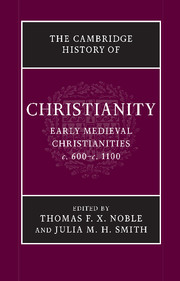Book contents
- Frontmatter
- Introduction: Christendom, c. 600
- Part I Foundations: Peoples, Places, and Traditions
- 1 Late Roman Christianities
- 2 The emergence of Byzantine Orthodoxy, 600–1095
- 3 Beyond empire I: Eastern Christianities from the Persian to the Turkish conquest, 604–1071
- 4 Beyond empire II: Christianities of the Celtic peoples
- 5 Germanic Christianities
- 6 Slav Christianities, 800–1100
- Part II Christianity in Confrontation
- Part III Christianity in the Social and Political Order
- Part IV Christianity as Lived Experience
- Part V Christianity: Books and Ideas
- Conclusion: Christendom, c. 1100
- Bibliographies
- Index
- References
2 - The emergence of Byzantine Orthodoxy, 600–1095
from Part I - Foundations: Peoples, Places, and Traditions
Published online by Cambridge University Press: 28 March 2010
- Frontmatter
- Introduction: Christendom, c. 600
- Part I Foundations: Peoples, Places, and Traditions
- 1 Late Roman Christianities
- 2 The emergence of Byzantine Orthodoxy, 600–1095
- 3 Beyond empire I: Eastern Christianities from the Persian to the Turkish conquest, 604–1071
- 4 Beyond empire II: Christianities of the Celtic peoples
- 5 Germanic Christianities
- 6 Slav Christianities, 800–1100
- Part II Christianity in Confrontation
- Part III Christianity in the Social and Political Order
- Part IV Christianity as Lived Experience
- Part V Christianity: Books and Ideas
- Conclusion: Christendom, c. 1100
- Bibliographies
- Index
- References
Summary
Introduction
The period from 600 to 1095 CE was a period of enormous change for the Byzantine Empire, the most significant cause of this change being the rise of Islam in the first part of the seventh century and the continuing presence in the east thereafter of an Arab empire. Islam administered a massive shock to the Byzantine world, from which it took the empire almost two centuries to recover. This recovery was nevertheless partly due to changes in the Arab empire itself, which, with the shift of its capital from Damascus to Baghdad in 750, became a much more eastward-facing society, thus relieving the pressure on Byzantium. For this initial period, 600 to 850, traditional historical sources are sparse, leaving us in ignorance about many issues. From the ninth century onwards, the Byzantine Empire began to recover, and in the tenth and early eleventh centuries, under the Macedonian dynasty, expanded and regained something of its former glory. The church shared in this new mood of expansion and prosperity, in which it found the opportunity to build on the sense of orthodoxy that had emerged with the repudiation of iconoclasm and the “Triumph of Orthodoxy” in 843. This sense of emergent Orthodoxy manifested itself in the realms of art and scholarship, in monastic revival and missionary expansion. Sources for this later period are more abundant, enabling much greater insight into the various facets of Christianity, as well as other aspects of the empire. For these reasons, the first part of this chapter, dealing with 600 to 850, will be primarily chronological, whereas the second part, dealing with the later period, will take a more thematic approach.
- Type
- Chapter
- Information
- The Cambridge History of Christianity , pp. 46 - 64Publisher: Cambridge University PressPrint publication year: 2008
References
- 2
- Cited by



